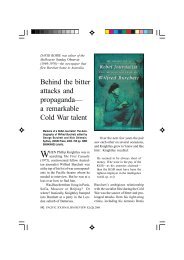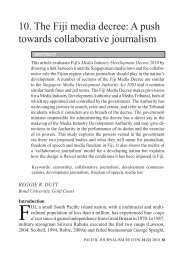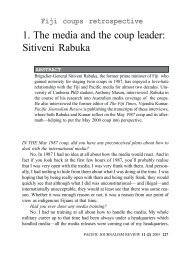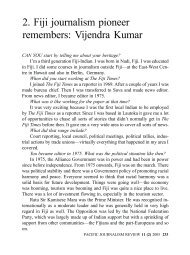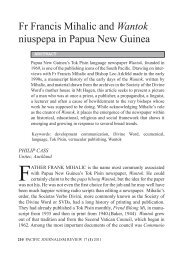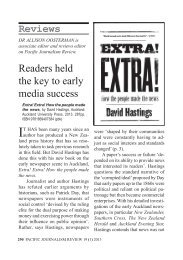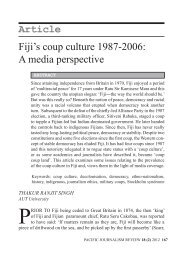1. A case study in ethical failure - Pacific Journalism Review
1. A case study in ethical failure - Pacific Journalism Review
1. A case study in ethical failure - Pacific Journalism Review
Create successful ePaper yourself
Turn your PDF publications into a flip-book with our unique Google optimized e-Paper software.
MEDIA ETHICS AND ACCOUNTABILITY<br />
organisations devoted to critiqu<strong>in</strong>g and enhanc<strong>in</strong>g the media (Pearson, 2004;<br />
Butler & Rodrick, 2004). The explicit or implicit purpose of these systems is<br />
to enable the media to play its role <strong>in</strong> representative democracy, ensur<strong>in</strong>g<br />
citizens can obta<strong>in</strong> <strong>in</strong>formation and communicate. So it is aga<strong>in</strong>st these broader<br />
democratic goals that M*A*S and journalism itself must f<strong>in</strong>ally be evaluated<br />
(See Bertrand, 2000; 2003). One way of do<strong>in</strong>g this is to look at the end product—the<br />
media content produced by journalists—and exam<strong>in</strong>e how adequately<br />
it reflects and responds to sources, audiences and events beyond the media<br />
itself. To explore further the implications of such an approach, <strong>in</strong> this article<br />
I have chosen a s<strong>in</strong>gle <strong>case</strong> <strong>study</strong>—the Australian media’s coverage of Aborig<strong>in</strong>al<br />
deaths <strong>in</strong> custody over a 20-year period. Chart<strong>in</strong>g the coverage of a<br />
s<strong>in</strong>gle issue helps move discussion of media accountability beyond rhetoric<br />
to a more practical discussion about the nature of gaps <strong>in</strong> coverage and what<br />
sort of strategies might help fill them.<br />
Media and democracy<br />
In review<strong>in</strong>g what role media might be expected to play <strong>in</strong> a democracy, James<br />
Curran summarised a set of requirements for a democratic media system:<br />
it should empower people by enabl<strong>in</strong>g them to explore where their <strong>in</strong>terest<br />
lies; it should support sectional group identities and assist the<br />
function<strong>in</strong>g of organisations necessary for the effective representation<br />
of group <strong>in</strong>terests; it should susta<strong>in</strong> vigilant scrut<strong>in</strong>y of government and<br />
centres of power; it should provide a source of protection and redress<br />
for weak and unorganised <strong>in</strong>terests; and it should create the conditions<br />
for open discussion of differences rather than a contrived consensus<br />
based on elite dom<strong>in</strong>ance. (Curran, 2002, p. 247)<br />
While some Australian journalists might embrace Curran’s requirements, others<br />
would baulk at see<strong>in</strong>g their role as one of support<strong>in</strong>g sectional group identities<br />
or protect<strong>in</strong>g the weak. However, nearly all would share Curran’s view<br />
that the media should ‘susta<strong>in</strong> vigilant scrut<strong>in</strong>y of government’ and create<br />
‘conditions for open discussion of differences rather than a contrived consensus<br />
based on elite dom<strong>in</strong>ance’. Such pr<strong>in</strong>ciples are encapsulated by the preamble<br />
to the MEAA Code of Ethics:<br />
(journalists) <strong>in</strong>form citizens and animate democracy. They give a practical<br />
form to freedom of expression. Many journalists work <strong>in</strong> private<br />
18 PACIFIC JOURNALISM REVIEW 11 (2) 2005



